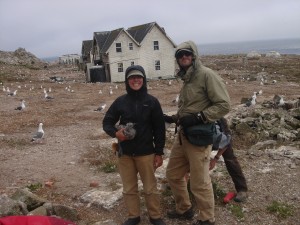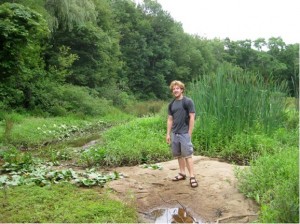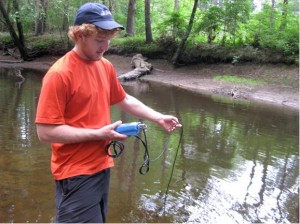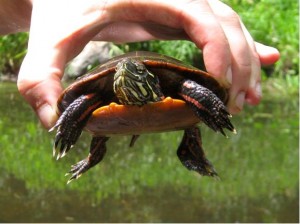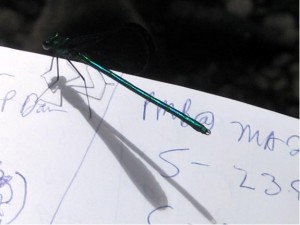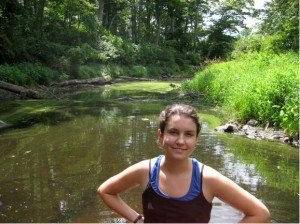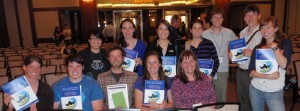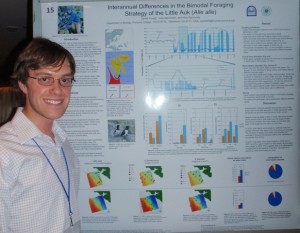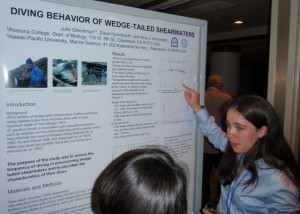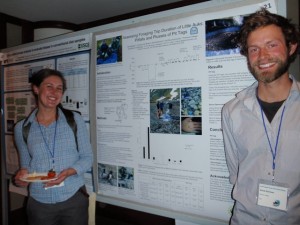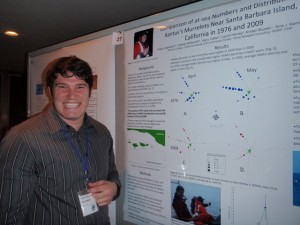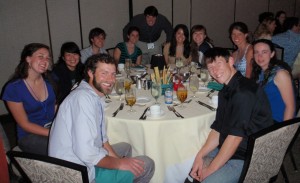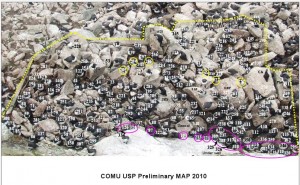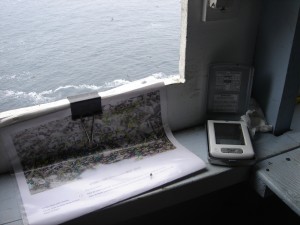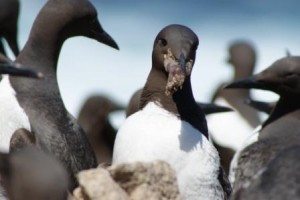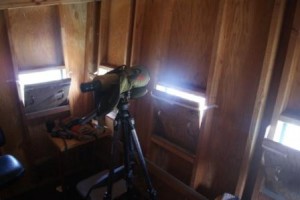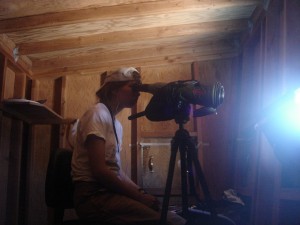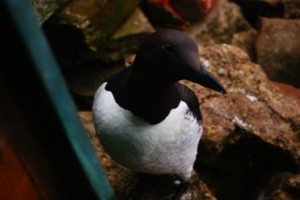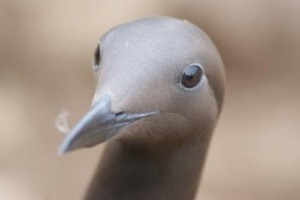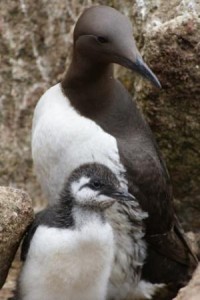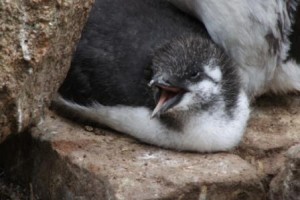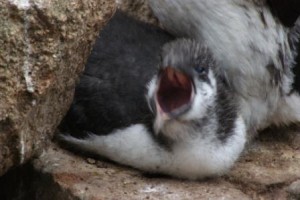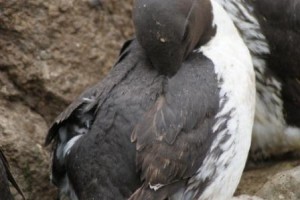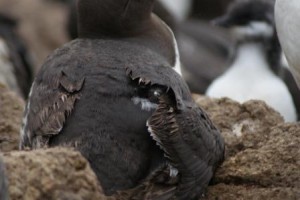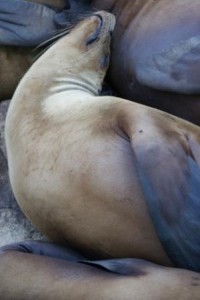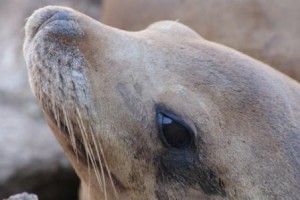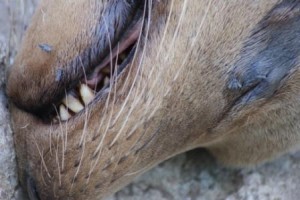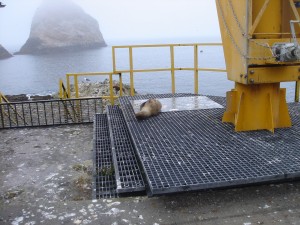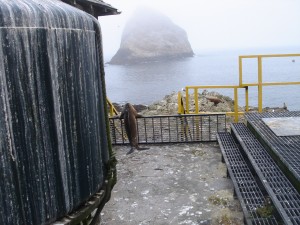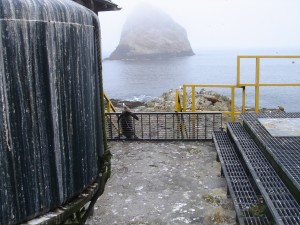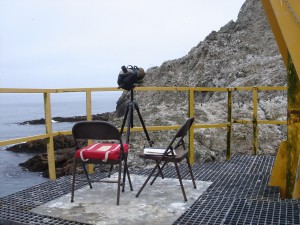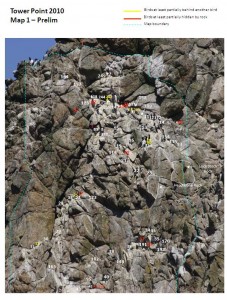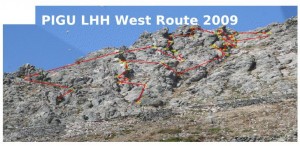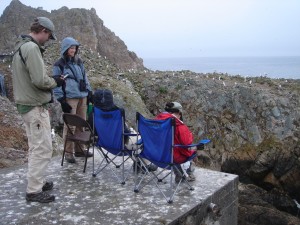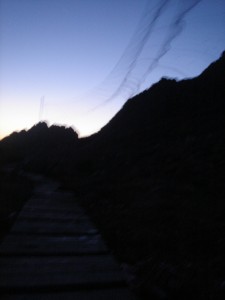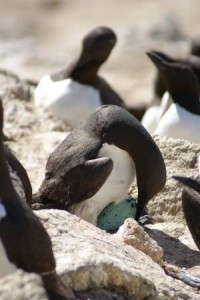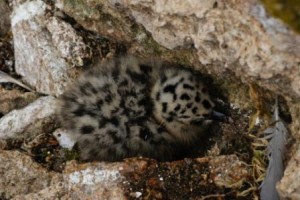An article has just been posted about summer “vacation” with pictures of Augie, Kristen and Charlotte:
SUMMERS of FEATHERS and FUN
Posted by: nina-karnovsky | August 18, 2010 | No Comment |as chicks fledge we enter data
Posted by: krm12008 | July 28, 2010 | No Comment |Hello again from the Farallons!
In the past few weeks we have been continuing/finishing up our studies on the various seabirds here. It was also recently my turn to update the official Farallon Island blog, here is a link to my post there: http://losfarallones.blogspot.com/2010/07/baby-chicks-diet-watchcollection.html
We finished Common Murre diet watch! Technically we were supposed to continue diet watch until only 10 chicks were in the plot, but because there were SO many feedings this year, our data’s sample size included over 7000 feedings (as compared to last year’s 1500 feedings), so Russ and Pete officially said we had plenty of data to work with.
Also, I dont know if I’ve mentioned this previously, but another one of Katrina’s studies that I took over when she unexpectedly left was her gull plot (H-East).
In gull studies, we follow gulls of known age (they are banded birds). They essentially claim a territory that they maintain throughout the season (usually for their lifetime, with their mate), and we have a special labeling system to identify them, and we monitor their breeding attempts.
You can resight gulls to! Here’s how (banded birds hang out a lot in San Francisco locales, like AT&T park, the SF zoo, Golden Gate Park, places where there is food, etc): You can first tell what year the bird hatched by its color combination, and you’re likely to see gulls between 3-15 years old (they have been known to live much longer, some of the gulls in my plot are way older than me!) we use a code that gives the order of the bands by upper left (upper band on the left leg) lower left (lower band on left leg), upper right, lower right. For example, blue-yellow-metal-nothing indicates a bird that has a blue band on its left leg above a yellow band also on its left leg, and only a metal band on its right leg. (Metal bands also have a number that you can usually read with some binoculars. If you actually see a bird and record its combo AND number, you can let the folks at PRBO.org know and they would be thrilled to hear about it!)
I’ll list the hatch year and the combo here starting with 1986:
1986: yellow-metal-nothing-nothing
1987: blue-metal-nothing-nothing
1988: green-metal-nothing-nothing
1989: black-metal-nothing-nothing
1990: reddishbrown-metal-nonthing-nothing
1991: gray-metal-nothing-nothing
1992: nothing-nothing-yellow-metal
1993: nothing-nothing-white-metal
1994: nothing-nothing-tan-metal
1995: nothing-nothing-green-metal
1996: white-nothing-metal-nothing
1997: nothing-nothing-blue-metal
1998: nothing-nothing-black-metal
1999: nothing-nothing-gray-metal
2000: yellow-nothing-metal-nothing
2001:blue-nothing-metal-nothing
2002: green-nothing-metal-nothing
2003: black-nothing-metal-nothing
2004: red-nothing-metal-nothing
2005: gray-nothing-metal-nothing
2006: metal-nothing-yellow-nothing
2007: metal-nothing-blue-nothing
2008: metal-nothing-white-nothing
2009: metal-nothing-green-nothing
2010: metal-nothing-black-nothing
So that means this year, all the chicks that are hatching are getting banded with a metal band (with numbers) on its left leg and a black plastic band on its right leg. After we band all the “followed” chicks (chicks hatched to at least one parent that had a band, thus of known-age, that bred within the plot boundaries), we choose a day where we do “saturation banding”, which is where we band ALL of the chicks, regardless of whether or not their parents have bands, within the plot boundaries. We don’t just band all the chicks on the island because we only band birds we expect to have to resight later and know the age of, and since western gulls tend to breed in the same plot they were hatched in, we only band within the plot.
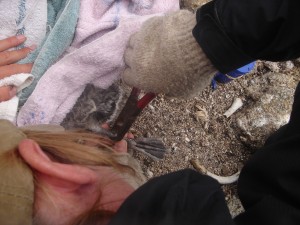 This is Melinda banding a gull chick. Banding gull chicks takes teamwork. Other species breed in crevices, burrows, or study boxes designed for animal-handling, but gulls breed out in the open and their chicks roam around. In order to handle a gull chick without scaring it (which causes it to run really fast away from us and into another gull’s usually-hostile territory), we have to circle it and slowly and gradually close in on it from all sides with towels, and as we get really close, one of us flings our towel on top of the gull which usually immediately calms it down (they like to be “hidden”), and then we can band it. Sometimes they fidget, which is why my hand is holding down this gull chick in the picture.
This is Melinda banding a gull chick. Banding gull chicks takes teamwork. Other species breed in crevices, burrows, or study boxes designed for animal-handling, but gulls breed out in the open and their chicks roam around. In order to handle a gull chick without scaring it (which causes it to run really fast away from us and into another gull’s usually-hostile territory), we have to circle it and slowly and gradually close in on it from all sides with towels, and as we get really close, one of us flings our towel on top of the gull which usually immediately calms it down (they like to be “hidden”), and then we can band it. Sometimes they fidget, which is why my hand is holding down this gull chick in the picture.
Sometimes, the gulls breed really close to other study sites, and when we check on these study sites, the gull chicks get scared and want to run away, so one of us has to hold on to the gull chick while the rest of us take/record data. Here is Jessie holding a gull chick while Michelle in the bottom left checks on a Rhinocerous Auklet box, and Russ next to Jessie.
After reading all that text, I’ll bet you want to see some more pictures, right???
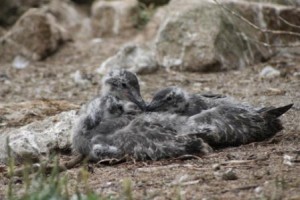 Three gull chicks, mostly feathered, roosting together.
Three gull chicks, mostly feathered, roosting together.
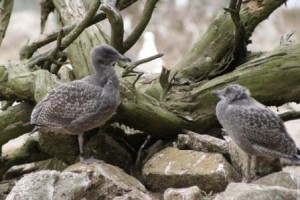 Two fully feathered chicks standing. They reach their adult plumage at about 2 years of age, and don’t start breeding until they’re about 4 or 5 years old.
Two fully feathered chicks standing. They reach their adult plumage at about 2 years of age, and don’t start breeding until they’re about 4 or 5 years old.
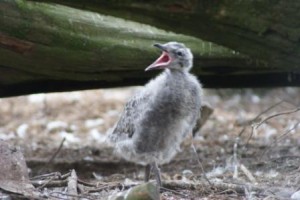 A gull chick begging for food from its parent, not pictured.
A gull chick begging for food from its parent, not pictured.
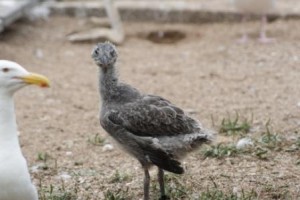 For some reason, some of the chicks can’t tuck their wings in properly, and their wings are always sagging and drooping. We don’t really know why this is happening, but its likely due to poor nutrition or some kind of contamination during the egg forming or incubation period. I personally think they are zombie gulls.
For some reason, some of the chicks can’t tuck their wings in properly, and their wings are always sagging and drooping. We don’t really know why this is happening, but its likely due to poor nutrition or some kind of contamination during the egg forming or incubation period. I personally think they are zombie gulls.
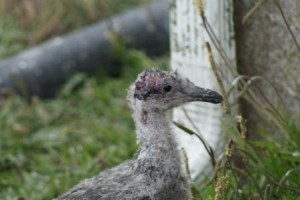 Poor parenting leads to injured or dead chicks. This chicks parents for some reason dont defend their territory regularly, and when they’re gone, this little chick gets beat up on by its neighbors. It’s still alive, though!
Poor parenting leads to injured or dead chicks. This chicks parents for some reason dont defend their territory regularly, and when they’re gone, this little chick gets beat up on by its neighbors. It’s still alive, though!
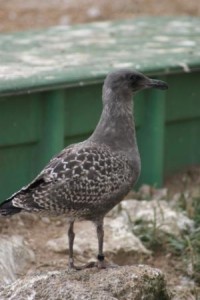 This is “Bobby”, one of the oldest chicks on the island. He’s totally fully-feathered and can fly nowadays, but as any chick would logically do, still returns to his parents territory as long as his parents still feed him when he begs. We try to refrain from naming the birds so that we don’t get too attached, but sometimes you can’t help it (and he wasnt a study bird).
This is “Bobby”, one of the oldest chicks on the island. He’s totally fully-feathered and can fly nowadays, but as any chick would logically do, still returns to his parents territory as long as his parents still feed him when he begs. We try to refrain from naming the birds so that we don’t get too attached, but sometimes you can’t help it (and he wasnt a study bird).
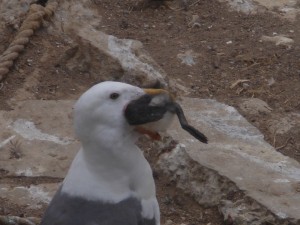 This WEGU found a meal of one of the Common Murre chicks. This is why you can’t get too attached to any wildlife. Wildlife are not pets. This is a common misconception amongst many people who dont understand why we don’t attempt to “save” every organism on the island. If we save all the chicks from much of their inevitable death, you get population explosions and then a concurrent resource depletion, leading to a population crash. Also, if you save all the chicks from the gulls, then some of the gulls might starve. Also, saving chicks from death wouldn’t allow us to study them at all since we wouldn’t be getting any idea about the birds ability to raise their own young. We are here to observe and report, not to interfere and meddle with complex food webs that we are still attempting to learn about.
This WEGU found a meal of one of the Common Murre chicks. This is why you can’t get too attached to any wildlife. Wildlife are not pets. This is a common misconception amongst many people who dont understand why we don’t attempt to “save” every organism on the island. If we save all the chicks from much of their inevitable death, you get population explosions and then a concurrent resource depletion, leading to a population crash. Also, if you save all the chicks from the gulls, then some of the gulls might starve. Also, saving chicks from death wouldn’t allow us to study them at all since we wouldn’t be getting any idea about the birds ability to raise their own young. We are here to observe and report, not to interfere and meddle with complex food webs that we are still attempting to learn about.
Alright, on to a different species.
Yesterday, I brought my camera out with us during a routine Cassin’s Auklet check to document a little.
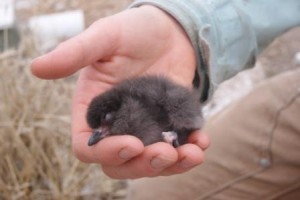 This is a very very tiny Cassin’s Auklet chick that was left alone a little earlier than it should have by its parent. We really really quickly took a weight and a very quick picture before hurriedly putting it back.
This is a very very tiny Cassin’s Auklet chick that was left alone a little earlier than it should have by its parent. We really really quickly took a weight and a very quick picture before hurriedly putting it back.
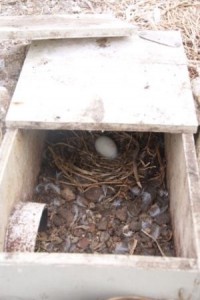 What a clean and organized box! Nice job, Cassin’s! This is a study box we use for Cassins. The top is kept covered with a shade and rocks on top so a gull can’t knock off the top and steal whats inside (we try to imitate the safety of the burrows Cassin’s usually dig out), and it has a tunnel that serves as an entrance/exit they use. When we check the boxes, we cover the tunnel with our knee or foot, and carefully lift up the top to look at the contents. Usually once a chick is hatched the box has a ton of poop and doesnt look this pretty. When an adult is first incubating its leg we check to see if the adult is banded and if it is of known-age, we take some measurements to record.
What a clean and organized box! Nice job, Cassin’s! This is a study box we use for Cassins. The top is kept covered with a shade and rocks on top so a gull can’t knock off the top and steal whats inside (we try to imitate the safety of the burrows Cassin’s usually dig out), and it has a tunnel that serves as an entrance/exit they use. When we check the boxes, we cover the tunnel with our knee or foot, and carefully lift up the top to look at the contents. Usually once a chick is hatched the box has a ton of poop and doesnt look this pretty. When an adult is first incubating its leg we check to see if the adult is banded and if it is of known-age, we take some measurements to record.
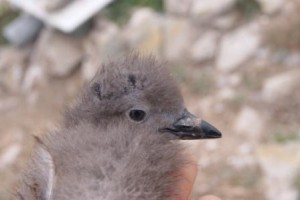 This is a partly-feathered Cassin’s Auklet chick that I weighed. It’s down is such a soft gray color! The iris of their eyes turns very milky-white at about age 4 or 5 years.
This is a partly-feathered Cassin’s Auklet chick that I weighed. It’s down is such a soft gray color! The iris of their eyes turns very milky-white at about age 4 or 5 years.
There also have been TONS of Cetaceans around the island this past week. We’ve been regularly seeing almost 100 humpback whales every day, including the usual 2 or 3 gray whales, and really exciting – 7 blue whales that have been hanging out! About 100 risso dolphins have also been feeding nearby, as well as some Pacific white-sided dolphins. I’ll bet there’s lots to see on those tourist whaler boats that come out here all the time. It’s kind of ridiculous how spoiled we get, if we only see a few humpback whales, the regular 2 gray whales, and a few other cetaceans, we’ll exclaim BORING! but in a kind of silly way because we totally know we’re so lucky to see all this amazing wildlife.
Anyway, I have to go back to entering data! I’m nearing the end of my 8-week stint here, which means I have to enter/analyze all the data onto computers that I’ve collected here out in the field so far. Hope you enjoyed the post (and don’t forget to check out the Farallon blog, Los Farallones! The link is at the top of the post!)
much love,
Kristina
FOR THE FISH!
Posted by: nina-karnovsky | July 25, 2010 | No Comment |The following is an update from Nik’11 who is working on an independent summer research project assessing the quality of herring habitat in MA in order to determine places where dam removal and restoration would be most beneficial for the herring.
Written by Nik:
There are two species of them: blueback herring (Alosa aestivalis) and the alewife (Alosa pseudoharengis).
Both are anadromous, which means that they live in the ocean but spend their youth in streams (for the blueback) and ponds (for the alewives). Every spring around April and May, millions of river herring swim up streams and rivers across the Atlantic Seaboard from Nova Scotia Florida. Each female will lay around 100,000 eggs, but most of the eggs and juveniles become food for other organisms. In fact, river herring are pretty much the Happy Meal equivalent for animals as diverse as striped bass, herons, snapping turtles, shad, seals, humans, and blue fish. The spawning run in spring and the fall migration of the juvenile herring to the sea is like one big all-you-can eat buffet.
That is, it was until river herring populations began a long decline back in the 18th century. Dams that block the herring’s upstream migration are one problem; another more recent one is bycatch by giant commercial trawlers for Atlantic herring that inadvertently sweep up hundreds of thousands of herring at once in their football field-sized nets. This decline led the Massachusetts Division of Marine Fisheries to announce a moratorium on the river herring fishery in 2005; state populations are just starting to recover.
For my project, I decided to focus on dams. If we could remove dams and restore herring runs, I thought to myself, there would be a bigger all-you-can-eat buffet, and more Happy Meals that would in turn lead to Happier bass, herons, turtles, seals, and even humans!!! etc. etc… You get the idea. And passage would not only be restored for river herring, but also brook trout, rainbow smelt, the American eel, American shad, the brook lamprey, and a number of other fish.
But before removing the dam, it helps to know whether or not the habitat upstream is good for the river herring. This can help get people interested in dam removal (“you know, it would be great to remove this dam because the habitat IS actually really good for the herring — here’s the data”) and also help the folks at the Division of Ecological Restoration and American Rivers (and other dam-removal-oriented groups with $) decide which dams to prioritize for removal. Plus, I can test my own hypotheses about how the dams are affecting the brook and river and pinpoint other problems (like streams running dry because of people using too much water — http://www.wickedlocal.com/hanover/topstories/x553801786/Hanover-Water-restrictions-in-effect).
So, after setting up my project (getting equipment, talking to the Division of Marine Fisheries, fine-tuning protocols, etc.) I have spent a little more than the past month monitoring 2 herring runs in-depth using the Division of Marine Fisheries’ protocol for river herring habitat assessment on the Satucket River and the Third Herring Brook (a stream that begins in my backyard). I collect data on five quantitative parameters — dissolved oxygen, pH, conductivity, salinity, and temperature — as well as several more qualitative observations like eutrophication, passage and passage impediments, and spawning substrate. So far both main spawning ponds look A-Ok for the juvenile herring, which is good since it’s been a hot July.
I am sincerely hoping that dam removal projects on both the Satucket and 3rd Herring Brook get kickstarted by my work! Knock on wood. More later.
Amy Briggs’10 (see Prairie posts) came out and helped!
Great Company makes for Great Times on the river!
Pomona dozen attends Pacific Seabird Group meeting
Posted by: nina-karnovsky | July 22, 2010 | 1 Comment |The Pomona group made three oral presentations and presented five posters.
Kristen Boysen’10 presented her senior thesis work with Karnovsky in the paper “Seasonal Changes in at-sea distribution of Xantus’s Murrelets and their prey near Santa Barbara Island’ for which she won Honorable mention for the Best Student Paper Award.
Zachary Brown’07 presented the paper, “Divergent diving behavior during long and short foraging trips in the little auk (Alle alle)” with co-author Karnovsky.
Derek Young’09 won the Best Student Poster Award for his poster “Interannual differences in the bimodal foraging strategy of the Little Auk (Alle alle)” which was based on senior thesis research with co-authors J. Gleichman’10 and Karnovsky.
Julia Gleichman’10 presented the poster, “Diving behavior of Wedge-Tailed Shearwaters” with co-author Karnovsky; this poster was based on her senior thesis results as well.
Elizabeth Ng’10 presented her senior thesis work with co-authors Amy Briggs’10 and Karnovsky in the poster, “Fish prey of Pygoscelis penguins in the Antarctic Peninsula Region.”
Nell Baldwin’10 presented the poster “Assessing foraging trip duration of little auks: pitfalls and plusses of PIT tags” with co-authors Zachary Brown’07, Derek Buchner’08, and Karnovsky.
Augie Lagemann’10 presented part of his senior thesis in the poster, “Comparison of at-sea numbers and distribution of Xantus’s Murrelets near Santa Barbara Island, California in 1976 and 2009” with co-author Karnovsky.
I chaired the session on the Behavioral Ecology of Seabirds and presented the paper, “In pursuit of plankton: the foraging behavior of Cassin’s auklets in the Gulf of the Farallones.” Co-authors of this paper included Eleanor Caves’11 and Charlotte Chang’10.
The meeting was attended by 250 seabird biologists from around the world. The research presented at the meeting was funded by grants to Karnovsky from the National Science Foundation, the Mellon Foundation and the Montrose Restoration Settlement Program.
pictures!
Posted by: krm12008 | July 16, 2010 | No Comment |So… I haven’t posted in a while… sorry! Things have been incredibley busyyyyy BUT i have pictures for you to make up for my absence!
Our schedules have been very crowded with Murre Diet Watch!
This is the map of the study plot we look at for Diet Watch. Each number represents a mate pair and its egg. As birds fly in with fish, we track which site they go to, what fish they brought in to feed their chick, and if they have bands, what their banding code is.
Diet Watch needs 2 people: 1 primary observer, who is supposed to watch the plot at all times and figure out the information to be recorded, and tells the secondary observer, who inputs the data into the palm pilot (pictured), and who is “back-up” in case more than 1 bird flies in at a time or the primary observer has to blow their nose or wipe their binoculars or double-check the map to figure out which site the bird went to.
We just finished our last all-day diet watch yesterday! yay! but 2 hour diet watches continue daily at consecutive time slots until only 5 chicks remain in the plot.
I’ve also picked up Katrina’s old job of murre census counts at Sea Lion Cove.
this is the inside of the the Sea Lion Cove blind (SLC). Since this blind is unique in that it was built in and amongst the birds, the windows cant be opened all the way without scaring all the birds into flying away, so they’re opened up just a crack. I have a little clicker-counter and there’s about 500-600 murres to count!
this is me looking through the scope to record the bands on Brandts cormorants that I see, and checking for nests and/or eggs
Since the windows are so close to their colony, there are a few wandering murres that get kind of curious and peer into the blind through the window.
It makes for great photo opps!
A lot of them have chicks! They’re getting big and right now many are fledging daily. There are about 250,o00 murres on this island, and if each pair had a chick, that would be about 125,000 chicks! wowzers
i caught this one mid-yawn
“im fat and full of fish!”
a lot of the chicks cuddle up against their parent, and so when you’re checking for chicks at a plot, a lot of the time all you can see is their little beak peeking out from under Mom or Dad’s wing. It must be warm under that wing!
Good job protecting your chick from gulls, murre!
sometimes the Zalouphus (California Sea Lions) hang out and snooze really close to the blind.
Sooooo cute, right?!?
WRONG they are stinky and loud! and when they dominate the area, the birds cant nest because the sea lions will trample them.
this one decided to take a nap on the platform I use to watch Tower Point Murres.
I had to chase him off the platform and down the stairs
But he wasn’t happy about it, and left me a very passive aggressive present – a big pile of stinky poop to shovel away. grrrr
Speaking of tower point, I had promised earlier to tell you all more about that study!
I sit here at North Landing (where boats used to get craned in before the new crane on East Landing) and look through that scope to “take attendance” on the Murres in two study plots across the gulch.
This is a map of one of the plots. I go through each site with my attendance sheet, and write “NP” if a bird is not present, “E” if I see a bird incubating an egg at the site, “C” if I see a bird with its chick at the site, “0” if there is a bird there with nothing under it, and “?” if after the 2 or so hours I spend taking attendance I cannot determine if the bird there has anything. There’s also special notation for when a neighbor attempts to “alloparent”, or sits on its neighbor’s chick or egg and feeds it. I’m not sure why they do that, but it tends to occur with neighbors that lost their chick to predation or egg from a failed hatch. Maybe they’re sad and jealous.
There’s also a second map with about the same number of sites to the left and below this “map 1” but the file was too big to upload. Sorry!
Also, on Saturday, Russ and Annie came back to the island! And a few days ago, Melinda Connors, an intern from 2005, came back for a two-week stint to help us out with our workload! (and cooking =D ) She’s doing a number of things, including daily checks on the Pigeon Guillemots that have been banded in Annie and my study of the PIGU breeding checks.
This is a map of one half of the sites that get checked during the PIGU breeding check that Annie and I do every 5 days. We climb to each site, which are mostly crevices in the rock, and check the contents of the site. If there is a chick, we weigh it and record its feathering status (downy, partly feathered, mostly feathered, or fully feathered), and if its mostly feathered to fully feathered, we band it! Once they get banded, they need to get checked daily to determine what day they fledge.
There is another half of the PIGU check, but I uploaded the wrong file, so I dont have a picture of it to post.. woops! It’s really similar to the other half, it’s just directly east of it and goes directly under the lighthouse. There are also about 25 sites in a old pile of rocks near “Garbage Gulch” that I dont have a picture of… sorry!!!!!!
just kidding! here is most of the crew doing a PIGU diet watch switch at the Garbage Gulch “rubble pile”. We do 2 shifts (7am – 9am and 9am-11am) every 3 days, and switch out turns at 9. PIGU diet watch is similar to Murre diet watch in that we record the site that got fed, the fish they brought in (their diet is a little different from Murres), and if they have bands, their banding combo. It’s a little easier in that their site numbers are painted on the rocks right next to their entrance, but harder because the overall plot is much larger and we’re farther away. We alternate doing diet watch at the Garbage gulch “rubble pile” and at Lighthouse Hill.
Also, we’ve been busy with nightwork!
its hard to get pictures after dark without using flash which we avoid since its not nice to the birds, but here is the setup of the net at around 9pm. We set up the mist-net and have it open usually around 9 and everyone but 2 people lay down by the sides of the net and wait for Rhinocerous Auklets to fly into it. They grab the bird out of the net, someone else picks up all the fish the bird was bringing back to its chick, and puts it into a baggie to process later, and the bird and baggie get “processed” at the house (we take measurements and band it if its new and not if its a recapture).
after we catch 5 incidental Cassin’s Auklets, we close the net, put everything away, and process the fish. We figure out the kind of meal each Rhino was bringing back for its chick by identifying all the fish and taking a few measurements on each fish, and put them in a freezer for more analysis later that we don’t do
Also, last week we netted for Ashy storm-petrels twice since we were in the right moon phase and the wind was under 10 knots (perfect conditions!). It’s easier than Rhino netting since Ashys are soooo tiny and managable but its also more tiring since its a 3 hour session from about 10:30 at night till 1:30 in the morning. I didnt get any pictures since the Ashys are really sensitive to light.
That’s all for now, this post took me 3 days of almost all of my free time to compose and upload pictures! i hope you enjoyed it
love, kristina
Chicks are everywhere!
Posted by: krm12008 | July 2, 2010 | 1 Comment |To say the last few days have been busy would be quite the understatement! Having 4 people do what essentially 6 people were meant to do can really make for a busy schedule.
Since Katrina’s absence, I’ve picked up her daily task in doing the noon weather and taking the surface sea temperature. The noon weather includes the direction of the wind (in radians), the strength of the wind (in knots), the cloud conditions, the rainfall (in inches, if any), the visibility (in miles), the air temperature (in Celcius), the air pressure (in mb), the swell, the state of the sea, the direction of the waves, and the surface sea temperature (which involves me suiting up in rainboots and a PFD, going to the intertidal near East Landing, and throwing a bucket into the water, hauling it up with a rope, and taking the temperature, 3 times, to get an average, and bottling a sample of it to get tested for various things in a lab back on the mainland).
Pete has been picking up the rest of Katrina’s slack in her regular studies since Jessie, Michelle, and I haven’t been trained on them, and thus we pull a little extra weight in the group studies and take over tasks that we can so that everything can still get done. For example, the PIGU breeding check, which happens once every 5 days, is split into “east” and “west” sections of Lighthouse Hill and other various parts of the island, and is done by two people (Annie and me, but while she’s been on break, Pete has covered for her) simultaneously, but yesterday I did all of the sights on Lighthouse Hill so that Pete could do both his “Upper Shubrick Point” Murre Plot and Katrina’s “Tower Point” Murre Plot. Doing the PIGU breeding check is no easy task! It’s basically a 5.2 – 5.3 rock climbing route (considered easy), but on granite covered in lichen, with some loose and crumbly rocks, with obstacles like gull nests that have eggs or chicks and very anxious, very aggressive parents, with gull chicks at their “runner” stage that you need to avoid scaring or else they’ll run off the cliff, and if you do scare them, need to try your best to grab them and put them back in their nest, and cover them with dead plants so they’ll calm down. And then grabbing the little Pigeon Guillemot chicks can be challenging too, as the adults lay eggs in crevices in the rocks that have little nooks and crannies the chicks can bury themselves into, so they do, and to reach them, sometimes you gotta bend your whole arm into this dark crevice, feeling for something – anything, and then all you can reach is their behind, so you try to get a grip on it, and then they very dependably squirt some saved up smelly and warm poop all over your hand, and you swear a little, and then you grab them by their little leg, and pull them out just enough to grab their body, and they scream and flap their little wee wings, and then you have the chick, and then you try to put it in a little cloth baggie to weigh it with the scale, but it bites your finger a few times first, because its mad and thinks its going to get eaten, but its adorable because it doesnt hurt at all, and then you weigh it, and then your hat flies off your head because the wind suddenly picked up, so you try to readjust your hat, but a nearby gull took the opportunity to poop in your hair, so you swear again, then readjust your hat, then finish recording the feathering status and weight of the chick, hold it in one hand, reach in again and grab its sibling, which has squirmed its way even farther into the crevice, same deal here, then you’re double fisting adorable little chicks and life is awesome, then you put the first one back, and weigh the second one, record it, make sure there are no gull chicks that decided to take cover underneath your feet or the unstable rock under your feet, and move on to the next site, which is… where? So bascially, PIGU breeding check is really, really fun. I didn’t mind taking Pete’s half … that much, even if the whole hill took about 4 and a half hours. I’m still learning where all the sites are, but in time I’ll get faster.
Anyway, since Katrina is not going to be returning for a while (at least it seems like not before I leave the island in a month), I will be taking over her Murre plot at Tower Point and try my best to finish X-plot in my spare time these next few days. I’ll elaborate on Tower Point in the next few days. I started that today, and essentially learned all the sites in the plot boundaries.
Today was especially long since we had an all-day diet watch AND rhinocerous auklet netting! I had the 6am-8am morning shift with Pete, which meant I got to watch the sun rise. Since an all-day diet watch calls for 28 man hours and we only had 4 people, all three of us interns had 3 shifts of 2 hours, and Pete pulled another 5 shifts of 10 hours total. (I had 2pm – 6pm as my 2 other shifts).
Last night, we started round 2 of Rhinocerous Auklet netting. Tonight, though it was windy, the evening still was incredibly beautiful, and as we waited for birds to come in, we watched the sun set. Windy conditions for rhino netting are not that great, since they bounce out of the net more easily. Once I get better pictures, I’ll finally describe Rhino netting a little more in detail.
On another note of great bird news, the Cassin’s Auklets are doing extremely well! Almost all of the chicks in my study have fledged and I havent come across a single abandonded chick at all, and tons of the same adult pairs are laying second broods! This means dealing with a lot of feisty parents that are a lot stronger than their chicks, but it also indicates high productivity in the sea. Who knew? It was predicted that the year would turn out poorly for the birds since it’s an El Nino year, but it seems like most of the species here are doing really well. It’s super exciting to find an adult incubating an egg on the 5-day check, and your reaction is, “yeah!”. When we find an adult, we grab it very quickly (so it doesnt accidently fracture its own egg in its struggle), check the band number against our book’s records to see if it was one of the same adults of the pair that laid the previous egg (if there was a previous egg), and if it is, weigh it, and get the measurements of the egg with a caliper. If it’s a new adult, we’d also have to get the beak depth and wing chord, but so far I think most of the adults we’ve found in our checks the last few days are second broods. Cassin’s Auklets are unique in that they tend to attempt a second brood after they fledge their first chick (each pair only lays one at a time) – other species can and do lay second eggs in the same season, but usually only if their egg or chick fails. After we find a relay (an attempt for a second brood by the same parent, NOT a relay race – hey, it’s an easy mistake, ok?), whoever’s study it is goes back the next day to get the band number and weight of the other parent, as the mates switch incubating the egg every day.
Sorry for the incredibly long entry without any pictures! I havent really even thought about taking pictures the last few days, but I’ll work on that!
Love, Kristina
And we are 4
Posted by: krm12008 | June 29, 2010 | 3 Comments |Today there was a lot of excitement on the island – but not cheerful excitement. Katrina, one of the other interns on the island, had to leave the island today for emergency medical reasons. She didn’t have any work-related accidents or anything severely serious, but had been having appendicitis-like symptoms and the medical practictioners she and Pete called recommended that she receive immediate care, so Pete was able to find a boat to take her home today. And now we are 4 – Pete the biologist, and 3 interns: Michelle, Jessie, and Me.
We all really hope that she will be fine and she will most likely be back with us on Saturday, unless she actually does need surgery or something, in which case she’ll return sometime later this summer.
Get well soon Katrina!
Yesterday we did Pigeon Guillemot diet watch on Lighthouse Hill, and today Pete and I did Murre diet watch from 11-1. I was able to get a couple pictures later this afternoon at a different blind thats much closer to the Murres.
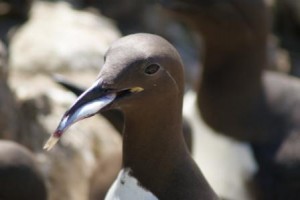 This Common Murre is holding a juvenile rockfish in its beak – you can identify that this is a rockfish by its silvery belly, its mottled red to brown back, and its barely forked tail that has collapsed to a forked square since it’s out of the water.
This Common Murre is holding a juvenile rockfish in its beak – you can identify that this is a rockfish by its silvery belly, its mottled red to brown back, and its barely forked tail that has collapsed to a forked square since it’s out of the water.
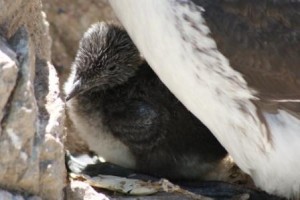 This is a Murre chick. It’s still pretty young. When they get to about fledging age, they look like little penguins! They can eat fish that are longer than they are tall – its pretty amazing. And scary.
This is a Murre chick. It’s still pretty young. When they get to about fledging age, they look like little penguins! They can eat fish that are longer than they are tall – its pretty amazing. And scary.
While Katrina is gone, we will all be covering her studies so things are going to be wayyy busy at least until saturday, when Russ, Annie, and potentially Katrina return, and Pete goes on vacation.
That’s all for now,
Love, Kristina
what’s your favorite band?
Posted by: krm12008 | June 27, 2010 | 2 Comments |Yesterday, we had some VIP’s come visit the island and get a very thorough tour from Pete! Jane Lubchenco, head of NOAA visited the island with an entourage of about 6 people, including the head of PRBO Ellie Cohen, the manager of the Farallon Island Wildlife Refuge Gerry McChesney (through US FWS), director of all wildlife sanctuaries in California, Nevada, and Arizona Dough Danbery, as well as other very important people whose titles i hate to admit i cant remember 100% accurately. They got to pet some downy-feathered chicks!
I thought I’d show you what some of the bands that we use to band birds with look like:
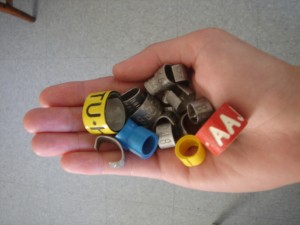 The big colored ones with “field letters” (very big lettering visible from farther away) are used for the Brandt’s Cormorants, the non-lettered colored ones are to band birds in 4-band combinations (2 on the left leg, 2 on the right), and the smallest numbered metal bands are used on the Cassin’s Auklets. The other medium-sized and large-sized metal bands are used in additon to the only-color bands on Murres and Pigeon Guillemots.
The big colored ones with “field letters” (very big lettering visible from farther away) are used for the Brandt’s Cormorants, the non-lettered colored ones are to band birds in 4-band combinations (2 on the left leg, 2 on the right), and the smallest numbered metal bands are used on the Cassin’s Auklets. The other medium-sized and large-sized metal bands are used in additon to the only-color bands on Murres and Pigeon Guillemots.
Today was our first all-day diet watch! from 6am at least 2 people have been up in the Murre Blind watching and recording EVERY fish that comes into the study plot, in 2-hour shifts, and currently Michelle and Pete are finishing up the 6pm – 8pm shift. I luckily didnt have the 6am-8am shift! I had 10-12, then again at 2-4, but it was a little more stressful than before since those were the shifts Pete wasn’t in the blind, and Michelle and I, and then later Jessie and I, were completely responsible for the Diet Watch. At times it was daunting, especially when 5 murres would fly into the plot at the same time! but we got it covered and it was accomplished.
Today was also the 15-day check of the known age birds, which includes checking a loooooot of boxes, which normally is done in a group of all the biologists and interns, but because of the diet watch, that would have been impossible, of course, so we split it up and got it done in shifts also.
anyway, PIGU diet watch is tomorrow again! this time i have 9am – 11am. I better go read up on my juvenile fish so I dont make any mistakes!
Also, here is a picture of a fully-feathered Cassin’s Auklet chick. It still has a bit of down at the butt and nape of its neck, but is “fully-feathered” because of all the feathers in its wings have grown in. Unfortunately, I didnt get a picture of that, because I’d have to have had 3 hands – 1 to hold the chick, 1 to spread its wing open, and 1 to take the picture – but i dont have three hands. so this shall have to do!
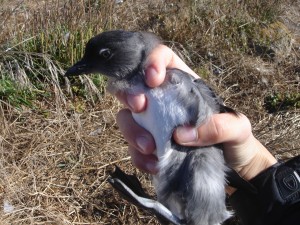 If you really wanted to know, this is the chick in burrow-box number 5 at “Heligoland Hill”
If you really wanted to know, this is the chick in burrow-box number 5 at “Heligoland Hill”
that’s all for now!
Love, Kristina
This isn’t Bodega Bay
Posted by: krm12008 | June 25, 2010 | 1 Comment |I thought I’d try to get a few pictures for today’s blog post!
So every day I watch “X plot” to try to confirm breeding sites. This means I watch a specified area of the cliff where Common Murres tend to hang out every day during the breeding season, and record which birds have used their little nook or cranny, the “site”, to incubate an egg and hatch a chick, and which are just hanging out there with no eggs.
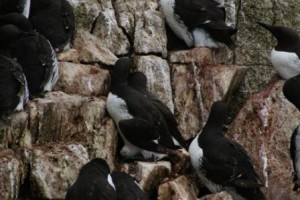 This bird is standing up, exposing the underside of the egg, which would mean that I can confirm that there it is used as a “breeding site”. The purpose of following breeding site is to help calculate the correction factor to estimate total populations after the species’ census is taken. To the right and on a lower rock is another Murre standing on top of its chick – you can just see the top of its dark head.
This bird is standing up, exposing the underside of the egg, which would mean that I can confirm that there it is used as a “breeding site”. The purpose of following breeding site is to help calculate the correction factor to estimate total populations after the species’ census is taken. To the right and on a lower rock is another Murre standing on top of its chick – you can just see the top of its dark head.
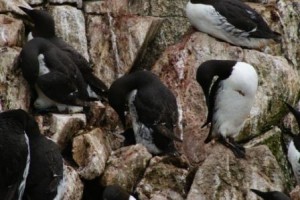 There he is! and bird on the left is checking out its egg. “Are you hatching yet?!? C’mon, I got fish to feed you! All the other chicks are hatching, why are you so slow?? Get cute now!” that last part may or may not be what I’m saying to the eggs.
There he is! and bird on the left is checking out its egg. “Are you hatching yet?!? C’mon, I got fish to feed you! All the other chicks are hatching, why are you so slow?? Get cute now!” that last part may or may not be what I’m saying to the eggs.
Also, gull chicks have taken over the island! sort of.
after a certain age (a week or two after hatch), they become what we like to call “runners”, and they run all over the place!
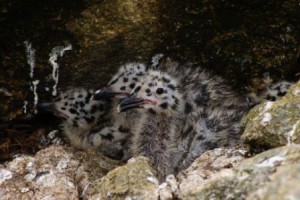 these guys are on the young side of “runner”
these guys are on the young side of “runner”
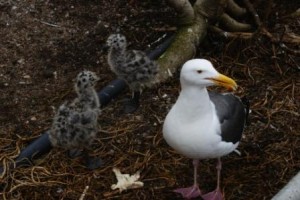 these are a couple of the largest i’ve seen yet. mom is standing nearby, obviously, as even chicks as big as these can get attacked (we saw one about this size almost get its neck broken by an aggressive adult nearby, but it got away! whew!)
these are a couple of the largest i’ve seen yet. mom is standing nearby, obviously, as even chicks as big as these can get attacked (we saw one about this size almost get its neck broken by an aggressive adult nearby, but it got away! whew!)
also, we did our five-day check on the known-age study of the Cassin’s Auklet, the PRBO study of the Cassin’s Auklet, and the Rhino Breeding Check.
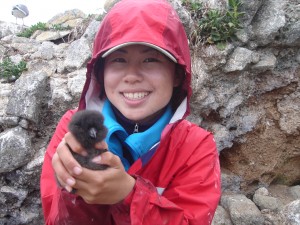 Here’s Michelle with a Rhinocerous Auklet chick! This one is real young and is still covered in down! (Downy-feathered chick)
Here’s Michelle with a Rhinocerous Auklet chick! This one is real young and is still covered in down! (Downy-feathered chick)
After this, I helped cover Jessie doing Brandt’s Cormorants re-sighting (where I sit in a blind and scope out the letter/number combinations of bands on BRCO’s hanging out/roosting/preening/sleeping/copulating/sitting/gathering nest material in a certain area of the island), since she had to do Murre Diet Watch from 5-7, which is usually when she does the re-sighting.
This was our first night of no night work since sunday, so we celebrated by watching a movie in the Coast Guard house next door! We watched Alfred Hitchcock’s “The Birds” which was pretty entertaining. The WEGU’s were featured in the movie, but depicted so much more viciously than they really are – even here. (The movie takes place in Bodega Bay, by the way)
Anyway, we’re all pretty tired out here, but we might get a VIP visit from the head of NOAA tomorrow, depending on the weather!
Updates soon,
Love, Kristina
PIGU diet watch!
Posted by: krm12008 | June 24, 2010 | 1 Comment |The past few days here on the Farallones have been really foggy! We’ve also had a few visitors – a pod of at least 8 humpback whales started hanging out near the southeast side of the island yesterday and seem to have been here today as well. Katrina describes them well – she says its like watching a fireworks show, since when they exhale, there are just spouts all over the place, and they’re constantly breaching and fluking, and again, my job is the best.
Today we started Pigeon Guillemot (PIGU) diet watch at 7am! It was a little tough getting up this morning, especially since we did Rhinocerous Auklet netting last night, but I’ve found diet watch to be one of my favorite activities, and I’m feeling more and more confident with fish identification so it’s less stressful than before. Pete, Katrina and I got camping chairs and sat near “Garbage Gulch” (where island residents back in the 1800’s would dump their garbage into the ocean), and watched the PIGU’s fly in with fish and fly to their breeding site where their chicks were waiting to be fed. Determining where the PIGU goes is a little easier than with the Murres because the site number is painted onto the rock, but we’re farther away so fish ID is a little more challenging. Katrina and I only had 2 hour shifts, so we were done at 9am, replaced by Jessie and Michelle, but poor Pete had to be there all 4 hours and it was stinkin’ cold! I went back to the house afterwards, but had to come right back out to the Murre Blind to try to see more sites, and on my way brought the crew some hot chocolate.
So in summary, today I did PIGU diet watch from 7am to 9am, afterwards I went to the Murre Blind for a couple hours to watch X-plot for more eggs (or chicks, as they’re all starting to hatch! the chicks look really funny – when they’ve just hatched, their downy has this whiteish-ness to it that makes them look like they have a frosted hairdo – very 90’s), I did my daily check on the Cassin’s Auklets (more fledges today!), had a quick lunch, helped Jessie out with the Brandt’s Cormorant breeding check (looking through a scope to check out all the nests that have been constructed with Brandt’s sitting in them, and waiting for them to stand up and shuffle around to record the eggs they have, if any), then had another Diet Watch with Pete up at the Murre Blind for the Murres from 3pm – 5pm. Today was also my day to cook dinner, so I made fried rice and a chinese dish my mom taught me that involves spinach and tofu. After dinner and dishes, we went out to do Rhinocerous Auklet netting for the 4th night in a row, and tonight I was doing data processing (which means I took a bunch of measurements on the rhinos we caught, banded new guys, and released them – which involves a little wrestling since these guys are strong, big, like to squirm, and bite hard and a lot).
So I failed to take any pictures, but I will try to tomorrow!
Pete says that though this year is an El Nino and things are always a little funky during el Nino years, but this year is especially strange that alot of bird activities are happening all at the same time, when usually they occur in a staggered time frame. According to Pete, usually the Murre chicks and PIGU chicks don’t hatch at the same time, so its unusual that both diet watches are starting at the same time, and to have rhino netting occuring at the same time is also somewhat unusual. Also, the Brandt’s Cormorants are behaving oddly this year – the past few years they have failed to fledge any chicks, but they are attempting again this year, but very very late (they all seem to be laying eggs this past couple of weeks), and the elephant seals are getting displaced from their usual sunning spots by the California sea lions. All in all, it adds up to a lot of work in a short period of time, but it’s very interesting to see how all these species react to their environmental conditions (which El Nino ultimately dictates), and to each other’s activities, and especially to the other individuals in their colonies, as they tend to mirror what everyone else is doing.
That’s all for now!
Love, Kristina

